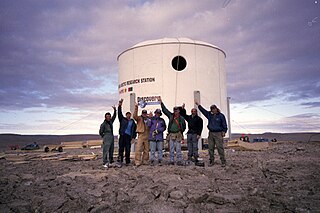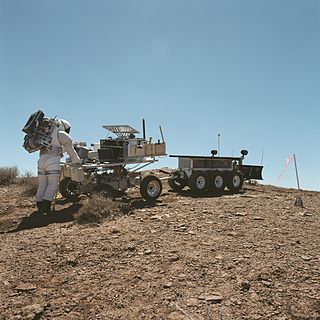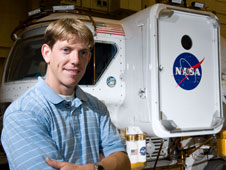

The Pavilion Lake Research Project (PLRP) is an international, multi-disciplinary, science and exploration effort to explain the origin of freshwater microbialites (similar to stromatolites) in Pavilion Lake, British Columbia, Canada.


The Pavilion Lake Research Project (PLRP) is an international, multi-disciplinary, science and exploration effort to explain the origin of freshwater microbialites (similar to stromatolites) in Pavilion Lake, British Columbia, Canada.
After a successful initial field season at the lake in 2004, Dr. Darlene Lim (SETI/NASA Ames Research Center) established the Pavilion Lake Research Project (PLRP) in partnership with Dr. Bernard Laval (University of British Columbia). In 2005, PLRP acquired support from the Canadian Space Agency's (CSA) Canadian Analog Research Network (CARN) program, which has allowed the research program to flourish and evolve. The project also successfully acquired a National Geographic Research and Exploration Grant in 2005, and NASA continues to provide logistics, and education and public outreach (E/PO) support to the PLRP mission. [1]
In addition to exploring the microbiolites of the lake, the PLRP is also an analogue testbed, a place to test out operations and procedures to better understand how to explore using humans on other worlds, while maximizing the amount of science that can be done under difficult conditions. While the lake is not a close physical analog to the Moon or Mars or an asteroid, the complex operations of the field team and back room in dealing with communications, power, safety, etc., make the project an excellent operational analog. The project's field research demands the seamless integration of science and exploration field activities in an underwater environment inherently hostile to humans. The physical, mental and operational rigors associated with PLRP field science and exploration activities are comparable to lunar and martian extra-vehicular activities (EVA) where scientific exploration is a key driver. [2]
For the last several field season, the PLRP has used Deepworker submersibles to enable the scientists to map and explore the deepest parts of the lake, and cover much more area underwater than was previously possible with scuba divers. Deepworker is equipped with HD video cameras, so the scientists who make observations underwater can compare their observations with back room scientists after their dive, and a sampling arm, allowing microbialite retrieval from the deepest depths of the lake. [3] While the operating environment is different, the Deepworkers share much in common with the Space Exploration Vehicles (SEV) that NASA is testing through the Desert Research and Technology Studies (Desert RATS) analog work. In fact, each year astronauts participate in the studies as scientist-pilots. In 2010, Chris Hadfield and Stan Love [4] participated.
The Lunar and Planetary Institute (LPI) is a scientific research institute dedicated to study of the solar system, its formation, evolution, and current state. The Institute is part of the Universities Space Research Association (USRA) and is supported by the Science Mission Directorate of the National Aeronautics and Space Administration (NASA). Located at 3600 Bay Area Boulevard in Houston, Texas, the LPI maintains an extensive collection of lunar and planetary data, carries out education and public outreach programs, and offers meeting coordination and publishing services. The LPI sponsors and organizes several workshops and conferences throughout the year, including the Lunar and Planetary Science Conference (LPSC) held in March in the Houston area.

The Flashline Mars Arctic Research Station (FMARS) is the first of two simulated Mars habitats established and maintained by the Mars Society.
Australia Mars Analogue Research Station (MARS-Oz) is a station in Australia where the Mars Society will conduct geological exploration under constraints similar to those found on Mars. In 1998, the United States Mars Society agreed to work with Mars Society Australia, a non-profit organisation dedicated to the eventual human settlement on the Red Planet, which allowed this project to be administrated in Australia. Led by project manager David Willson, this will be the fourth Mars Analogue Research Station Program. The three previous stations were built in Devon Island in Arctic Canada in July 2000, a desert near Hanksville, Utah, and the Adler Planetarium in Chicago. The main objective behind the research is to anticipate and resolve conflicts that will arise on a Martian exploration by having a group of scientists and engineers work together and live in an analogue Mars environment.

Pascal Lee is co-founder and chairman of the Mars Institute, a planetary scientist at the SETI Institute, and the Principal Investigator of the Haughton-Mars Project (HMP) at NASA Ames Research Center in Mountain View, California. He holds an ME in geology and geophysics from the University of Paris, and a PhD in astronomy and space sciences from Cornell University.

The Astrogeology Science Center is the entity within the United States Geological Survey concerned with the study of planetary geology and planetary cartography. It is housed in the Shoemaker Building in Flagstaff, Arizona. The Center was established in 1963 by Eugene Merle Shoemaker to provide lunar geologic mapping and to assist in training astronauts destined for the Moon as part of the Apollo program.
The Universities Space Research Association (USRA) was incorporated on March 12, 1969 in Washington, D.C. as a private, nonprofit corporation under the auspices of the National Academy of Sciences (NAS). Institutional membership in the association currently stands at 113 universities. All member institutions have graduate programs in space sciences or technology. Besides the 98 member institutions in the United States, there are two member institutions in Canada, four in Europe, two in Israel, one in Australia and one in New Zealand, one in Hong Kong, two in Korea and two in the United Kingdom.

Venera-D is a proposed Russian space mission to Venus that would include an orbiter and a lander to be launched in 2029. The orbiter's prime objective is to perform observations with the use of a radar. The lander, based on the Venera design, would be capable of operating for a long duration on the planet's surface. The "D" in Venera-D stands for "dolgozhivushaya," which means "long lasting" in Russian.

NASA's Desert Research and Technology Studies is a group of teams which perform an annual series of field trials seeking to demonstrate and test candidate technologies and systems for manned exploration of the surface of the Moon, Mars, or other rocky bodies.

David Stewart McKay was Chief Scientist for astrobiology at the Johnson Space Center. During the Apollo program, McKay provided geology training to the first men to walk on the Moon in the late 1960s. McKay was the first author of a scientific paper postulating past life on Mars on the basis of evidence in Martian meteorite ALH 84001, which had been found in Antarctica. This paper has become one of the most heavily cited papers in planetary science. The NASA Astrobiology Institute was founded partially as a result of community interest in this paper and related topics. He was a native of Titusville, Pennsylvania.
The Solar System Exploration Research Virtual Institute (SSERVI), originally the NASA Lunar Science Institute, is an organization, established by NASA in 2008, that supplemented and extended existing NASA lunar science programs. Supported by the NASA Science Mission Directorate (SMD) and the Exploration Systems Mission Directorate (ESMD), SSERVI is a NASA program office located at the NASA Ames Research Center and was modeled on the NASA Astrobiology Institute (NAI) with dispersed teams across the nation working together to help lead the agency's research activities related to NASA's human exploration goals. Competitively selected team investigations focused on one or more aspects of lunar science investigations of the Moon, from the Moon, and on the Moon.

Astrobiology Science and Technology for Exploring Planets (ASTEP) is a program established by NASA to sponsor research projects that advance the technology and techniques used in planetary exploration. The objective is to enable the study of astrobiology and to aid the planning of extraterrestrial exploration missions while prioritizing science, technology, and field campaigns.

Andrew Frank Jorgensen Abercromby is a scientist and biomedical engineer who designs and tests spacesuit systems and exercise countermeasures for future exploration of the solar system. He is employed by NASA as Lead of the Human Physiology, Performance, Protection & Operations (H-3PO) Laboratory at Johnson Space Center in Houston, Texas. As an aquanaut, Abercromby served as a member of the NASA Extreme Environment Mission Operations 14 crew. Abercromby has more than fifteen years of experience working in the Human Health and Performance (HH&P) and Engineering Directorates at the Johnson Space Center. He is married with two daughters.
Human analog missions are activities undertaken on Earth in various environments to simulate aspects of human missions to other worlds, including the Moon, asteroids, and Mars. These remote field tests are performed in locations that are identified based on their physical similarities to the extreme space environments of a target mission. Such activities are undertaken to test hardware and operational concepts in relevant environments.

Christopher E. Gerty is an American aerospace engineer who worked on NASA's Constellation Program. Gerty is an advocate of NASA's Open Government Initiative and is a leading voice on the concept of participatory exploration and collaboration. He has fifteen years of experience working on complex, technology-intense projects at NASA. Gerty served as an aquanaut on the NASA Extreme Environment Mission Operations 13 crew.
Tara Melaine Ruttley is Associate Chief Scientist for Microgravity Research at NASA Headquarters in Washington, DC. Prior to this, she was Associate Program Scientist for the International Space Station (ISS) at NASA's Johnson Space Center in Houston, Texas. Until 2007, she was lead hardware engineer for the ISS Health Maintenance System, leading a team of engineers whose job was to provide reliable medical equipment that kept astronauts healthy in orbit. She subsequently served as the lead hardware engineer for the ISS Human Research Facility. She served as an aquanaut on the NASA Extreme Environment Mission Operations 6 crew in July 2004.
Terrestrial analogue sites are places on Earth with assumed past or present geological, environmental or biological conditions of a celestial body such as the Moon or Mars. Analogue sites are used in the frame of space exploration to either study geological or biological processes observed on other planets, or to prepare astronauts for surface extra-vehicular activity.

Margarita Marinova is a Bulgarian aeronautical engineer. She is the Senior Mars and Vehicle Systems Development Engineer at SpaceX.
International Lunar Exploration Working Group(ILEWG) is a public forum sponsored by the world's space agencies to support "international cooperation towards a world strategy for the exploration and utilization of the Moon - our natural satellite".

Darlene Sze Shien Lim is a NASA geobiologist and exobiologist preparing astronauts for the scientific exploration of the Moon, Deep Space and Mars. Her expertise involves Mars human analog missions, in which extreme landscapes like volcanoes and Arctic deserts serve as physical or operational substitutes for various planetary bodies. She has become a leading public figure for Mars exploration, having presented her missions publicly at academic institutions and public events around the world. She has also discussed her work for various media groups such as NPR, The New York Times, and The Washington Post.